#fluorescent in situ hybridization
Text
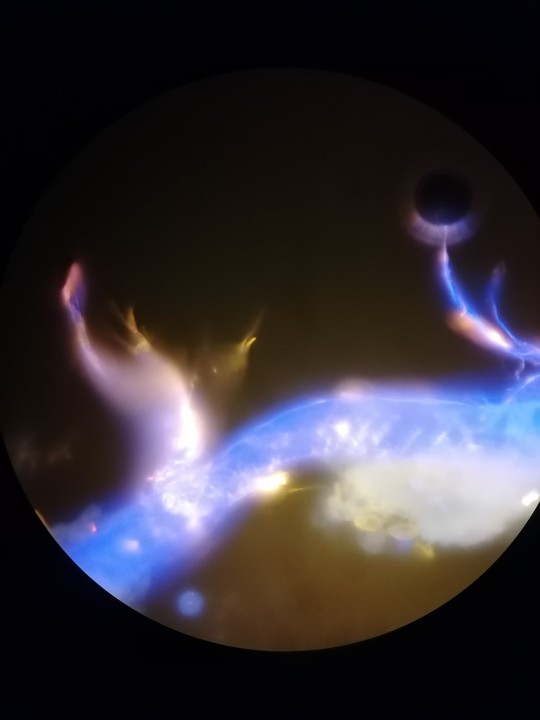
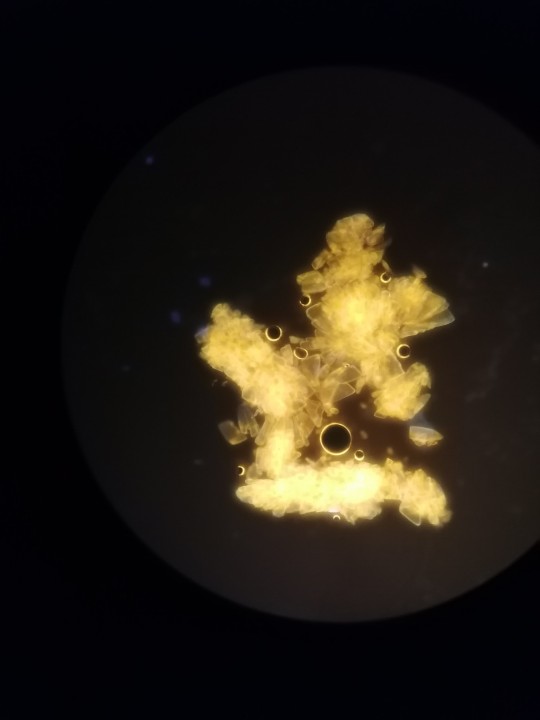
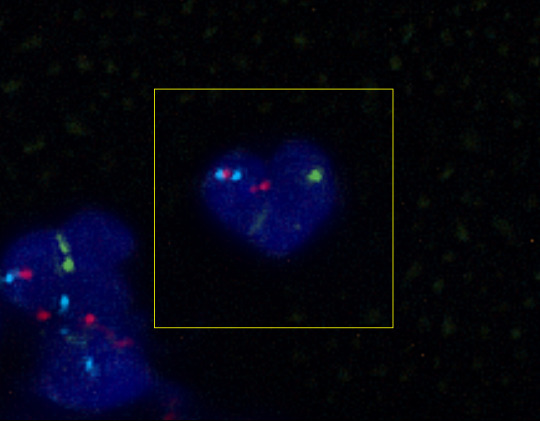
Since I'm so busy with work, I thought, why not upload some work pics?
Dunno if it's something anyone here'll find interesting, but I think they're pretty XD
12 notes
·
View notes
Text
If I was a chromosome would you denature me, hybridize me, anneal fluorescent probes to me, then look at my DNA under a microscope?
#microbio#concept#biologie#Fluorescent In Situ Hybridization#I know this one's gonna flop but at least I think I'm funny
1 note
·
View note
Text
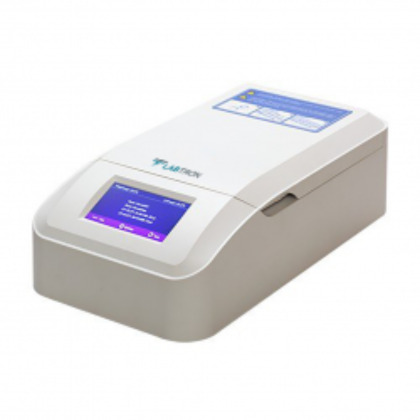
FISH Hybridization System LFHS-A10 is programmable system and humidifying that automates the steps in a
slide-based FISH procedure. It offers capacity of 12 slides and temperature control ranges from RT+5°C to 99.9°C.
Designed with touch screen easy to read, program and adopts four operation modes: denaturation/hybridization,
hybridization fixed temperature, custom, In-situ PCR. Two-side heating of slides that allows achieving exact
correspondence of the set and actual temperature and maintaining uniform temperature across all slide positions.
It is easy to use and reduces hands-on time by more than 50% while ensuring overall precision and accuracy in all
slide-based assays. It is ideally suited for the needs of cytogenetic laboratories to provide a good instrument.
0 notes
Text
Fluorescence In Situ Hybridization (FISH) Imaging Systems Market Forecast 2024 to 2032
Fluorescence In Situ Hybridization (FISH) Imaging Systems are specialized laboratory tools used in molecular biology and cytogenetics to visualize and analyze specific DNA or RNA sequences within cells or tissue samples. FISH is a powerful technique that allows researchers and clinicians to identify and map the location of specific genes or chromosomal abnormalities with high precision. FISH imaging systems enable the visualization of these molecular targets using fluorescent labels and advanced microscopy.
The Fluorescence In Situ Hybridization (FISH) Imaging Systems Market was valued at USD 803.23Million in 2022 and is expected to register a CAGR of 4.79% by 2032.
Ongoing advancements in genetic research and the increasing understanding of the role of specific genes in health and disease drive the demand for FISH imaging systems. Researchers use FISH to study gene expression, chromosomal abnormalities, and genetic variations.
Get A Free Sample
Mentioned below are the prime players taken into account in this research report:
Martha Tilaar Group
INIKA Cosmetics
Ivy Beauty
Colgate-Palmolive
Jetaine
Wipro Unza Holdings
INGLOT
Muslimah Manufacturing
Market Segments
This report has explored the key segments: by Type and by Application. The lucrativeness and growth potential have been looked into by the industry experts in this report. This report also provides sales, revenue and average price forecast data by type and by application segments based on sales, price, and value for the period 2017-2028.
Halal Cosmetics and Personal Care Segment by Type
Hair Care Products
Skin Care Products
Color Cosmetics Products
Fragrance Products
Halal Cosmetics and Personal Care Segment by Application
Online Retail
Offline Retail
Read More
#Fluorescence In Situ Hybridization (FISH) Imaging Systems Market#Hybridization Imaging Systems#Imaging Systems
0 notes
Link
#yellow cockatiel bird male or female#white cockatiel bird male or female#what is Single Nucleotide Polymorphism#what is RFLP#what is mtDNA#what is Mitochondrial DNA#what is NGS#what is Restriction Fragment Length Polymorphism#what is Polymerase Chain Reaction#what is Microsatellite analysis#what is DNA Microarrays#What is DNA Testing for Birds#what is Fluorescence in situ hybridization#what is DNA-DNA hybridization#what is DNA Barcoding#what is Chromosome painting#Species Identification#The Reliable Solution For Bird Gender Identification#Vocal Cues#TiktokParrot#Polymerase Chain Reaction in birds#parrot bird male or female#parrot Gender Determination#peach faced lovebird male or female#parrots Genetic disease screening#parrot Vocal Cues#parakeet bird male or female#love birds male female difference#love birds male female identification#male bird vs female
0 notes
Text
#flourescent in situ hybridization#in situ hybridization market#fluorescence in situ hybridization probe#fish probe market trends#fish probe market analysis#fish probe market size
0 notes
Text
Fluorescence In Situ Hybridization Probe Market risks and challenges that the industry is facing
Fluorescence In Situ Hybridization Probe Market risks and challenges that the industry is facing
This report studies the Fluorescence In Situ Hybridization Probe Market with many aspects of the industry like the market size, market status, market trends and forecast, the report also provides brief information of the competitors and the specific growth opportunities with key market drivers. Find the complete Fluorescence In Situ Hybridization Probe Market analysis segmented by companies,…
View On WordPress
#Covid-19 Impact Analysis#Fluorescence In Situ Hybridization Probe#Fluorescence In Situ Hybridization Probe forecast#Fluorescence In Situ Hybridization Probe Industry#Fluorescence In Situ Hybridization Probe Market#Fluorescence In Situ Hybridization Probe price#Fluorescence In Situ Hybridization Probe report#Fluorescence In Situ Hybridization Probe research#Fluorescence In Situ Hybridization Probe share#Fluorescence In Situ Hybridization Probe trends
0 notes
Text
what if i meditated on the train and it cured me . what if i memorised the part of the paper i read w her
to confirm the presence of typical neuronal synaptic transcripts in cluster 7 astrocytes i didn't kiss you even once tonight. we performed multiplex fluorescence in situ hybridization (RNAscope HiPlex assay) analysis of hippocampal slices from (my brain and it revealed stars and your voice) conditionally expressing red tdTomato reporter in astrocytes under the night sky where we met i wish i hadn't hated you so much and co-immunostained for two additional astrocytic markers GS and the blood in my heart spilling out and flowing to you (Fig 1g). we targeted four neuronal genes involved in glutamatergic vesicular exocytosis (Slc17a7 Slc17a6 you didn't have a pulse or a heartbeat no matter how hard i pressed my head to your chest) and found that they were strongly expressed not only in glutamatergic neurons (Fig. 1g (top)) but also in your eyes are amber-red and they will keep looking at another and another and another. i'm going to look away from you. this is what we observed at the molecular level. i never felt hungry for food around you so i just watched you drink red wine until i got my fill.
22 notes
·
View notes
Text
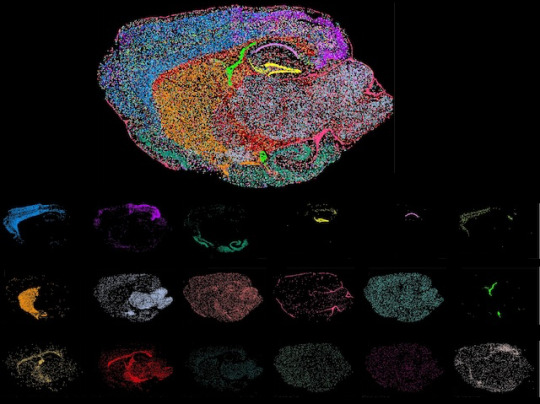
All Together Now
Profiling single cells within tissues according to the activity of multiple genes using methods called Fluorescence In Situ Hybridization of Cellular HeterogeneIty and gene expression Programs (FISHnCHIPs) enables mapping of cell types within a tissue while preserving its architecture. Different cell types in a mouse whole brain section are shown in the image individually and as a composite
Read the published research article here
Adapted image from work by Xinrui Zhou and Wan Yi Seow, and colleagues
Genome Institute of Singapore, Agency for Science, Technology and Research (A*STAR), Singapore, Singapore
Image originally published with a Creative Commons Attribution 4.0 International (CC BY 4.0)
Published in Nature Communications, March 2024
You can also follow BPoD on Instagram, Twitter and Facebook
12 notes
·
View notes
Text

Feferi x Karkat
Possible shipname pulled from my ass: Fluorescence in situ hybridization
18 notes
·
View notes
Text
I'm working in a molecular biology laboratory while getting ready for medical school, and one of the essential techniques we have to do is called smFISH (single-molecule fluorescent in situ hybridization), a way to detect the precise locations of RNA molecules in a cell by tagging the cell with fluorescent probes that bind to the RNA, and then viewing it under a microscope.
The most common protocol the lab currently uses is called "Stellaris," which is bad enough. Yet I feel deeply indebted to fate that despite all the stupid names biotechnology companies make up, at least no one at the manufacturer suggested calling the protocol "Signalis" (which would be more appropriate!) because if I heard my professor utter the name "Signalis" in the lab, I would immediately climb up the walls and start barking like a dog.
13 notes
·
View notes
Text
Oligonucleotide Synthesis Market Analysis And Segment Forecast 2024-2030
The global oligonucleotide synthesis market size was estimated at USD 3.68 billion in 2023 and is projected to grow at a compound annual growth rate (CAGR) of 13.21% from 2024 to 2030.
The decreasing prices of sequencing have led to increasing demand for custom-made nucleotides for applications across genetic testing, research, forensics applications, and drug development. This has further boosted the demand for oligonucleotide synthesis. The COVID-19 pandemic has affected every market globally and there has been a surge in the demand for efficient treatment against COVID-19.
Gather more insights about the market drivers, restrains and growth of the Oligonucleotide Synthesis Market
Oligonucleotide therapeutics hold immense potential for treating chronic conditions such as cardiovascular diseases, cancers, and retinal disorders. Emerging new applications of oligo sequences in multiple fields of biotechnology are expected to increase market growth. Demand for molecular diagnostics in precision care is an important emerging application field for oligonucleotide synthesis.
The introduction of advanced techniques such as CRISPR and high-throughput sequencing for gene expression analysis has simplified the genetic screening and modification of genomes. Such innovations are observed to influence the demand for oligonucleotide synthesis. Manufacturers invest in technology development to enable the production of long Oligonucleotides with higher precision and better yield to cater to the growing need for custom oligos.
The availability of a regulatory environment that supports the progress of genomics is the key factor contributing to the market growth. Changes in the regulatory policies to provide a well-framed environment for advanced biological research and application in human use are expected to influence demand for oligonucleotide synthesis significantly. Stem cells, regenerative medicine, genetic engineering, and synthetic biology are the prominent fields identified with high potential in healthcare. For instance, the International Society for Stem Cell Research (ISSCR) ethics and public policy committee aims to recognize and resolve issues by conducting open discussions. The committee includes experts in ethics, law, and social policy worldwide.
Oligonucleotide Synthesis Market Segmentation
Grand View Research has segmented the global oligonucleotide synthesis market report based on product & service, application, and region:
Product & Service Outlook (Revenue, USD Million, 2018 - 2030)
• Oligonucleotides
o DNA
o Column-based
o Array-based
o RNA
o By Technology
o Column-based
o Array-based
o By Type
o Short RNA Oligos (<65 nt)
o Long RNA Oligos (>65 nt)
o CRISPR (sgRNA)
• Equipment/Synthesizer
• Reagents
• Services
o DNA
o Custom Oligo Synthesis Services
o 25 nmol
o 50 nmol
o 200 nmol
o 1000 nmol
o 10000 nmol
o Modification Services
o Purification Services
o RNA
o Custom Oligo Synthesis Services
o 25 nmol
o 100 nmol
o 1000 nmol
o 10000 nmol
o Modification Services
o Purification Services
Application Outlook (Revenue, USD Million, 2018 - 2030)
• PCR Primers
o Academic Research Institutes
o Diagnostic Laboratories
o Pharmaceutical - Biotechnology Companies
• PCR Assays & Panels
o Academic Research Institutes
o Diagnostic Laboratories
o Pharmaceutical - Biotechnology Companies
• Sequencing
o Academic Research Institutes
o Diagnostic Laboratories
o Pharmaceutical - Biotechnology Companies
• DNA Microarrays
o Academic Research Institutes
o Diagnostic Laboratories
o Pharmaceutical - Biotechnology Companies
• Fluorescence In Situ Hybridization (FISH)
o Academic Research Institutes
o Diagnostic Laboratories
o Pharmaceutical - Biotechnology Companies
• Antisense Oligonucleotides
o Academic Research Institutes
o Diagnostic Laboratories
o Pharmaceutical - Biotechnology Companies
• Other Applications
Regional Outlook (Revenue, USD Million, 2018 - 2030)
• North America
o U.S.
o Canada
• Europe
o Germany
o U.K.
o France
o Spain
o Italy
o Denmark
o Sweden
o Norway
• Asia Pacific
o China
o Japan
o India
o South Korea
o Australia
o Thailand
• Latin America
o Brazil
o Mexico
o Argentina
• Middle East and Africa (MEA)
o South Africa
o Saudi Arabia
o UAE
o Kuwait
Browse through Grand View Research's Biotechnology Industry Research Reports.
• The global optical genome mapping market size was valued at USD 104.1 million in 2023 and is expected to grow at a CAGR of 26.76% from 2024 to 2030.
• The global therapeutic drug monitoring market size was valued USD 1.80 billion in 2023 and is projected to grow at a CAGR of 3.8% from 2024 to 2030.
Key Companies & Market Share Insights
Some of the key players operating in the market include Merck KGaA, Thermo Fisher Scientific, Inc., and Agilent Technologies. These players focus on business strategies such as partnerships/collaborations, product launches, and expansion. Twist Bioscience, Biolegio, and LGC Biosearch Technologies are some of the emerging market participants in the oligonucleotide market. These players primarily focus on expansion and partnerships to strengthen their position in the market.
Key Oligonucleotide Synthesis Companies:
• Thermo Fisher Scientific, Inc.
• Merck KGaA
• Danaher Corporation
• Dharmacon Inc.
• Agilent Technologies
• Bio-synthesis
• Kaneka Eurogentec S.A
• LGC Biosearch Technologies
• Biolegio
• Twist Bioscience
Recent Developments
• In October 2023, IDT inaugurated a new therapeutic manufacturing facility to meet the increasing demand in genomic medicine. The new facility is equipped to support the production of therapeutic oligonucleotides, catering to the expanding needs in the field of genomics and personalized medicine.
• In September 2023, Danaher Corporation (Integrated DNA Technologies) introduced a range of xGen NGS products tailored for the Ultima Genomics UG 100TM platform. The suite includes adapters, primers, and universal blockers, catering to various applications such as DNA, RNA, & methylation sequencing workflows. This offering is complemented by IDT's proven hybridization capture chemistry, enhancing versatility for researchers.
• In July 2023, Analytix introduced two new instruments designed for organic synthesis, including wavePREP, tailored for oligonucleotide synthesis, and Xelsius, a workstation for multireaction synthesis.
• In May 2023, GenScript expanded its life sciences facility in Zhenjiang, Jiangsu, China, to offer a rapid, high-purity oligonucleotide and peptide synthesis service tailored for research & development as well as preclinical applications.
• In May 2023, Twist Bioscience and CeGaT GmbH launched the Twist Alliance CeGaT RNA Fusion Panel. This collaborative effort aims to provide a specialized tool for oncology research, facilitating the detection of RNA fusions and enabling transcript variant analysis. RNA fusions, a result of chromosomal arrangements often seen in cancers, can now be efficiently studied using this newly introduced panel.
• In February 2023, Fluor Corp. and Agilent Technologies, Inc. collaborated to enhance its oligonucleotide therapeutics manufacturing facility in Frederick, Colorado. Under this collaboration, Fluor is expected to support the project's engineering and procurement. The total value of the project is evaluated at USD 725 million.
Order a free sample PDF of the Oligonucleotide Synthesis Market Intelligence Study, published by Grand View Research.
#Oligonucleotide Synthesis Market#Oligonucleotide Synthesis Industry#Oligonucleotide Synthesis Market size#Oligonucleotide Synthesis Market share#Oligonucleotide Synthesis Market analysis
0 notes
Text

FISHView Solid FISH Imaging System for Accurate Analysis | DSS Image
Find the FISHView Solid FISH Imaging System at DSS Image, designed for exact and reliable fluorescence in situ hybridization (FISH) analysis. Ideal for complex chromosomal analyses and diagnostic research.
0 notes
Text
0 notes
Text
The HER2 gastric cancer market is set for a steady ascent from 2024 to 2032, with a compound annual growth rate (CAGR) of 3.12%. The market’s size in 2024 is 1340.56 million USD, and it’s projected to escalate to 1714.07 million USD by 2032. Gastric cancer, a prevalent and often fatal malignancy, continues to pose a significant global health challenge. Among its various subtypes, HER2-positive gastric cancer has garnered considerable attention due to its distinct biological characteristics and therapeutic implications. HER2, or Human Epidermal Growth Factor Receptor 2, is a protein that promotes cell growth, and its overexpression in gastric cancer cells is associated with aggressive disease progression and poor prognosis. The HER2 gastric cancer market has evolved rapidly in recent years, driven by advancements in targeted therapies and personalized medicine, offering hope for improved patient outcomes.
Browse the full report at https://www.credenceresearch.com/report/her2-gastric-cancer-market
Market Dynamics
The HER2 gastric cancer market is shaped by a complex interplay of factors, including the rising incidence of gastric cancer, advances in diagnostic technologies, the development of targeted therapies, and growing awareness of personalized treatment approaches. According to the World Health Organization (WHO), gastric cancer is the fifth most common cancer worldwide, with over a million new cases diagnosed annually. Although HER2-positive gastric cancer represents only about 10-20% of these cases, the need for specialized treatments has spurred significant market growth.
Advancements in Diagnostics and Treatment
One of the key drivers of the HER2 gastric cancer market is the improvement in diagnostic capabilities. The introduction of more accurate and accessible testing methods, such as immunohistochemistry (IHC) and fluorescence in situ hybridization (FISH), has facilitated the identification of HER2-positive patients. Early and precise detection is crucial, as it allows for the timely initiation of targeted therapies, which can significantly improve survival rates.
The development of targeted therapies has revolutionized the treatment landscape for HER2-positive gastric cancer. Trastuzumab (Herceptin), the first HER2-targeted therapy approved for gastric cancer, has been a game-changer, improving overall survival in combination with chemotherapy. The success of Trastuzumab has paved the way for the development of other HER2-targeted agents, including pertuzumab, trastuzumab deruxtecan, and tucatinib, each offering different mechanisms of action and potential benefits.
Challenges and Opportunities
Despite these advancements, the HER2 gastric cancer market faces several challenges. One of the primary obstacles is the development of resistance to HER2-targeted therapies. Many patients eventually progress despite initial treatment success, necessitating the exploration of combination therapies and novel treatment strategies. Additionally, the high cost of targeted therapies can limit access, particularly in low- and middle-income countries, where the burden of gastric cancer is often highest.
However, these challenges also present opportunities for innovation. The ongoing research into overcoming resistance mechanisms has led to the investigation of new drug combinations and next-generation HER2 inhibitors. Furthermore, the integration of biomarker testing into routine clinical practice has the potential to refine patient selection and optimize treatment outcomes, ensuring that the right patients receive the most effective therapies.
Regional Market Insights
The HER2 gastric cancer market exhibits regional variations, reflecting differences in gastric cancer incidence, healthcare infrastructure, and access to advanced treatments. Asia-Pacific, particularly East Asia, represents the largest market due to the high prevalence of gastric cancer in countries like Japan, South Korea, and China. In contrast, North America and Europe have smaller patient populations but benefit from robust healthcare systems and greater access to innovative therapies.
In Asia-Pacific, the market is expected to grow rapidly due to increasing awareness, improved diagnostic capabilities, and the introduction of new targeted therapies. Governments in the region are also investing in cancer care infrastructure, which is likely to further boost market growth. Meanwhile, in North America and Europe, the focus is on expanding the use of combination therapies and overcoming treatment resistance, with ongoing clinical trials playing a pivotal role in shaping the future treatment landscape.
Future Outlook
The HER2 gastric cancer market is poised for continued growth as new therapies and diagnostic tools are developed and integrated into clinical practice. The trend towards personalized medicine, where treatments are tailored to the individual patient based on genetic and molecular profiling, is expected to drive innovation and improve outcomes for HER2-positive gastric cancer patients. Moreover, the increasing emphasis on combination therapies, addressing resistance mechanisms, and expanding access to targeted treatments in emerging markets will be crucial in shaping the future of this dynamic market.
Key Player Analysis:
Roche (Herceptin)
Merck (Keytruda)
AstraZeneca (Tagrisso)
Daiichi Sankyo (Enhertu)
Bristol Myers Squibb (Opdivo)
Genentech
MacroGenics
Seattle Genetics
Pfizer
Takeda
Segmentations:
By Therapy:
Chemotherapy
Immunotherapy
Radiation Therapy
Targeted Therapy
By Stage:
Stage I
Stage II
Stage III
Stage IV
By End-User:
Ambulatory surgery centers,
Hospitals and Specialty clinics
Others
Based on the Geography:
North America
US
Canada
Mexico
Europe
Germany
France
UK
Italy
Spain
Rest of Europe
Asia Pacific
China
Japan
India
South Korea
South-east Asia
Rest of Asia Pacific
Latin America
Brazil
Argentina
Rest of Latin America
Middle East & Africa
GCC Countries
South Africa
Rest of Middle East and Africa
Browse the full report at https://www.credenceresearch.com/report/her2-gastric-cancer-market
About Us:
Credence Research is committed to employee well-being and productivity. Following the COVID-19 pandemic, we have implemented a permanent work-from-home policy for all employees.
Contact:
Credence Research
Please contact us at +91 6232 49 3207
Email: [email protected]
Website: www.credenceresearch.com
0 notes